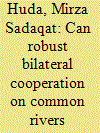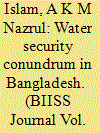|
|
|
Sort Order |
|
|
|
Items / Page
|
|
|
|
|
|
|
| Srl | Item |
| 1 |
ID:
120414


|
|
|
|
|
| Publication |
2013.
|
| Summary/Abstract |
The Himalayan river system, which is made up of the Ganges, Brahmaputra and Meghna rivers, has a combined drainage area that covers the countries of China, India, Nepal, Bhutan and Bangladesh. The basin of the Indus river, which originates in the Tibetan plateau, is the lifeline of regions in China, Pakistan, India and Afghanistan. The perception of the subcontinent being an India-centric region does not arise solely from the disparities in resources and power, but also from the geographic reality of all countries in the region sharing a border with India, and some of the most significant rivers passing through its territory. India, thus, stands in a unique position to initiate vigorous multilateral cooperation on water issues in the region. Despite this, the low level of integration, perennial conflicts, mistrust and misinformation that have plagued relations between South Asian countries have hindered regional cooperation on water security.
|
|
|
|
|
|
|
|
|
|
|
|
|
|
|
|
| 2 |
ID:
117742


|
|
|
|
|
| Publication |
2012.
|
| Summary/Abstract |
At the global level, use of water has increased significantly and it is on the rise, while its availability and access have reduced. Water is inherently linked to the growing challenges of the present day civilisation that include food security, health, economic growth, and poverty alleviation. In Bangladesh, availability of and access to water have appeared to be a significant obstruction to the survival and livelihood of its people and, sustainable economic growth of the country. Being the lowest riparian country in the Eastern Himalayan River systems, the water ecosystem of Bangladesh is vulnerable to unilateral upstream actions since a major share of surface water in the country comes from outside the border. This paper highlights that the main reason of Bangladesh water crises is the low flows of water due to upstream intervention by India which significantly affects surface water availability in Bangladesh during the dry period. Thus, during the dry period there always remains a gap between the need and availability. There is an increasing dependence on the use of groundwater which is depleting very fast due to over exploitation by a huge population. Climate change is likely to worsen the situation further. Due to severe gaps between the demand and supply of water there is a distressing impact on the live and livelihood of the population of Bangladesh which are manifested on the environment/non-traditional security sphere of the country. These, in course of time are likely to be posing severe threat to the security and stability of the country. The paper concludes that the management of common water resources taking into account the totality of Bangladesh-India common rivers could hardly be achieved without the involvement of all other stake holders which may include the Eastern Himalayan River systems co-basin states, particularly Nepal and Bhutan.
|
|
|
|
|
|
|
|
|
|
|
|
|
|
|
|
|
|
|
|
|